NEDA Mine Bat Hibernaculum
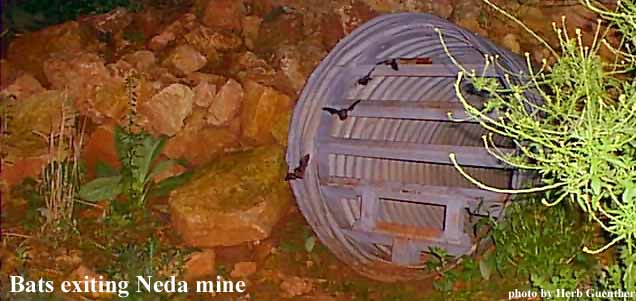
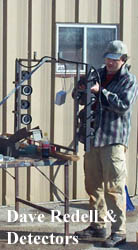
The NEDA Mine Bat Hibernaculum
in Dodge County, Wisconsin
is owned and operated by the University of Wisconsin-Milwaukee and is home to an estimated 75,000 bats. Research at the mine is coordinated through the UWM Field Station under the direction of Jim Reinartz. In 2001 I was asked to create a device that could monitor the directional movement of bats entering and leaving the mine
openings at Neda Mine. Working with then graduate student David Redell and UWM Field Station director Jim Reinartz I developed a detection system that projects an infrared beam onto a pair of infrared phototransistors. Bats passing through the light beam trigger an electronic circuit that produces an electrical pulse. A separate pulse is generated for incoming and outgoing activity. The pulses are then time stamped and counted by a Campbell Scientific Micrologger device.
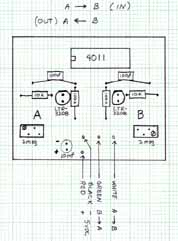
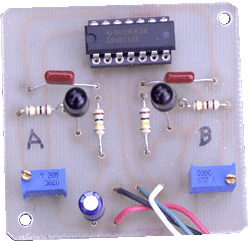
My bat detector is a curious device that monitors two photo transistors, A and B, for two unique darkness sequences.
If the phototransistors go dark from A to B then an IN coming Pulse is genetated.
If the phototransistors go dark from B to A then an OUT going Pulse is generated.
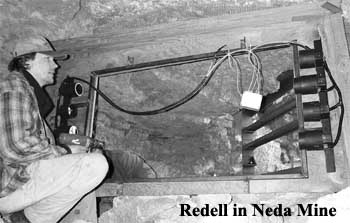
The Emitter and Detector electronics are housed inside PVC head units that are built from standard 3" PVC pipe and connectors. The Emitter and Detector head units are then attached to a welded metal frame. This metal frame is attached to a wooden frame that is mounted to the cave opening itself.
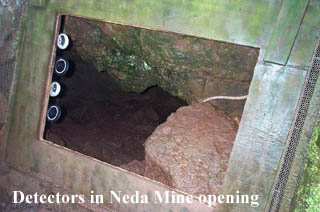 Four sets of detectors have been installed into mine openings at Neda. Each set uses a four beam arrangement. The devices work great and are in use today. Bat activity is monitored at the four openings all rear round.
Four sets of detectors have been installed into mine openings at Neda. Each set uses a four beam arrangement. The devices work great and are in use today. Bat activity is monitored at the four openings all rear round.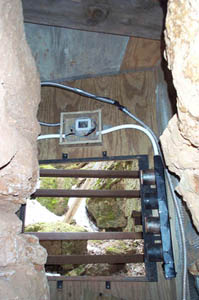
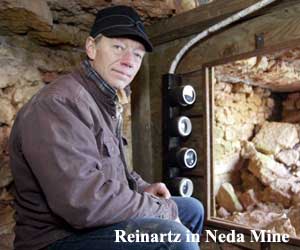
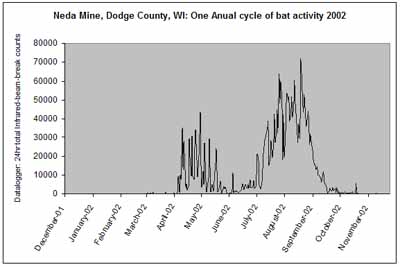
My detection system works very well monitoring bat activity and is producing a lot of good data. Redell
used the system for his Master's Thesis, "The Behavioral Ecology of Bats using the Neda Mine Hibernaculum" (2005). Redell has developed a way to count large numbers of bats using a statistically accurate method. Pairing observation with actual data his statistical procedure provides the scientific basis for accurate population counts inside the mine.
Currently the system collects data 365 days a year and is operated and maintained by the UWM Field Station.
 You can read about the Neda Mine installation in the Winter 2006 edition of BAT RESEARCH NEWS. Volume 47: No.4 "Detecting Directional Movement at a Hibernaculum with an Infrared Beam-break System"
You can read about the Neda Mine installation in the Winter 2006 edition of BAT RESEARCH NEWS. Volume 47: No.4 "Detecting Directional Movement at a Hibernaculum with an Infrared Beam-break System"
Many things were learned from this first generation system. The photoelectronic basis for detecting the direction of movement was determined to be solid. But there were difficulties with alignment, adjustment and stability in the harsh environment of a mine opening. Building upon the successes of my first detectors and redesigning the problem areas we have developed a new and improved bat detection system. In August 2006 the new 'second generation' detectors were installed into a mine opening at the Maiden Rock Mine .
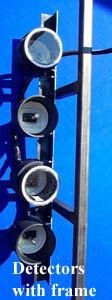 Contact:
Contact:
Daniel Shurilla
Electronic Research Technician
Email: dannys@shurilla.com
David Redell, M.S.
Ecological Inventory & Monitoring
Bureau of Endangered Resources
Email: David.Redell@Wisconsin.gov
Jim Reinartz
Director UWM Field Station
Email: jimr@uwm.edu







 Four sets of detectors have been installed into mine openings at Neda. Each set uses a four beam arrangement. The devices work great and are in use today. Bat activity is monitored at the four openings all rear round.
Four sets of detectors have been installed into mine openings at Neda. Each set uses a four beam arrangement. The devices work great and are in use today. Bat activity is monitored at the four openings all rear round.


 Contact:
Contact: